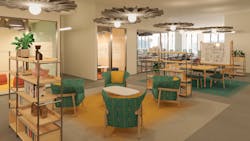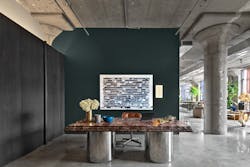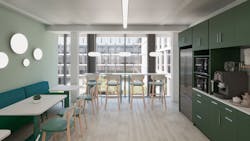As the dust settles three years later, small to mid-size design and architecture firms are now able to stop and take a proper look around to determine their position after the pandemic. Where it’s finding many of them is on a new playing field with their clients and colleagues alike, with lots of unfamiliar implications for material selection, work hours, financing and more.
Below, we speak with owners and executives who reflect on the past to show how they’re learning to address it all moving forward.
The Ground Rules
At the onset of COVID-19, when everyone entered the unknown with manufacturing’s supply and demand capabilities, clients were forced to become more involved in the decision-making process than ever before, said Naslha Espinal, executive director of interior design and marketing with BASE4 in Palm Spring North, Fla. She would be conversing with clients about which ports supplies would enter, how materials could be shipped and more.
And as everyone scrambled to figure it all out, there was more work to be done while project costs were slashed in half and client expectations (and confusion) doubled. Limited production and supply chain capabilities had a domino effect, with questions arising around if delays were a “design issue” or a “manufacturer issue,” and why prices were going up all around. First and second choices for products had to be chosen and additional costs for storage incurred. Designers were forced to restructure their contracts to account for these changes. But within the past few months, Espinal has noticed storage fees have been either integrated into business’ fees or removed since needs were outsourced locally.
Fauzia Khanani, founding principal at Studio Fōr in New York City, saw similar difficulties, with some clients having ordered hundreds of thousands of dollars worth of furniture, but delays in carpet or glass partitions per say required clients to pay for storage for the furniture until the other elements of the project were completed.
“We did end up having to bill a lot of additional services because everything was so delayed and continued to be delayed even when we were back in the office,” said Khanani. “We spent so much time following up on projects or looking for alternative materials that were in stock. That was a real difference between pre-COVID and during COVID and even now. Lead times have improved and are kind of back to normal, but there are still specific materials—such as certain AV components—that are months and months delayed. That means we have to spend more time on the project.”
Some firms billed clients hourly for services based on the project type, rather than a flat rate. Season-specific trends also saw (and continue to give) tighter windows for purchase, so clients now discuss additional options with designers when projects are several months out.
“Sometimes, when you specify something that is too trendy or popular it might be a problem in a few months when you go to purchase it, so we ask them to select the one that is their favorite and then have a back-up ready to go without having to rush anything or make a selection out of nowhere,” explained Espinal.
Khanani is also noting this lean toward more timeless designs as a lesson from the pandemic.
“They want to make sure that it’s going to last,” she said. “With a lot of our designs, we had to sit down and think, ‘What is the future of this technology? What is the design intent and design style going to be in 10 years?’ I don’t think clients are going to spend money like they have been, so you have to think about more timeless design versus trendy design.”
Over at INC Architecture & Design also in New York City, Adam Rolston, founding partner, creative and managing director, says today, technology advances have become more integrated in their practice, increasing clients’ expectations and shortening deadlines. For example, “Bluebeam software has become central to our design process by allowing us to collectively circulate and mark up drawings,” he said. Another more recent positive has been the closing of the gap in pricing between unsustainable synthetics and nontoxic materials. “Prior to the pandemic, it would take more of an effort to use natural and non-toxic materials because of the cost differential,” Rolston explained.
The industry has also adjusted to production shifts with GC’s, owners and developers staying more abreast of the market’s changes to avoid budget cuts midway through construction. However, Espinal noted the new challenge is financing, which could be a result of a looming economic recession.
“Even though the budget is a certain figure, if financing is not 100% secure, they try to keep their budget as low as possible just so we are not in a pickle when/if the financing doesn’t come through,” she said.
The Players
The pandemic catapulted the mobile lifestyle and established a more concrete permanency when it comes to hybrid work schedules. This has pushed many studios to evolve their organizational structure into one that resembles more of a collective, some doing away with the traditional hierarchy all together.
At INC, they found long ago that a top-down hierarchy is inefficient, consolidates power and hoards resources. Instead, staff are encouraged to debate and converse in a way that celebrates their diverse ways of thinking, which results in their “secret sauce” of mentorship by radical transparency. They work with two consultants to maintain that transparency, both internally and externally: Kelly Tigera of Proof Consulting analyzes the sharing and organization of information, business development and capture content; Tiana Webb Evans of ESP Group helped the studio shape its narrative and share it.
Studio Fōr practiced by joining forces with other firms during the pandemic, making them equivalent to a larger one, resulting in quicker deadlines and better outcomes for the client.
At BASE4, the horizontal structure of leadership focuses on servant leadership and promotes cohesion amongst the team. Espinal maintains her executive role and responsibility while also staying engaged in projects. She noted though that there is a struggle to break that hierarchical barrier at first.
“I am still a designer as well. I know what’s happening and I understand the complaints and it makes me understand the market more and what is needed,” she explained. “They feel more connected to you as their leader because you feel for them since you are going through the same thing on the project.”
The Morale
In addition to its obvious impacts on projects, COVID-19 heightened the importance of mental health and work/life balance. Companies’ various approaches to address employees’ mental health needs continue to evolve but they center mainly on giving people the opportunity to disconnect completely.
“It felt like there was this assumption that because everyone was home, we were working all the time,” Khanani said of client views during the pandemic lockdowns. So, upon return, they piloted different models that would feel less overwhelming for people after working from home exclusively for so long. The result was a 9-hour shift for four days and a half day working from home on Fridays.
“It’s trying to blend being in the office together—which is more productive and collaborative—with the mental state of comfort people get working at home,” Khanani said. “It is different than pre-COVID for sure, but I don’t know if it’s better or worse. I just say to people, it’s just different. We all must adjust.”
BASE4’s approach began with a human services survey to assess everyone’s views on returning to in-person workspaces. Much of the India-based office team elected to return to the office, whereas the Dominican Republic-based office team wanted to remain remote. To maintain comradery, the company set up a quarterly event for them to come together. BASE4 also arranged regular checkups with the company psychologist early in the pandemic. Now, follow ups are less frequent, but Espinal noted they realize employees are human first.
“Communication can be a struggle and can come off harsh—it takes time to hone in on that style of communication,” Espinal said. She noted that it is wrong to generalize the effects COVID-19 had on employees, especially since there are multiple generations represented.
“Some people didn’t care and thought it was great to work from home,” she said. “Some thought it was the worst thing that could happen. We have teams and team leaders. The executive would reach out to the team leaders to talk about each person.”
INC offers a $1,000 grant that employees apply for to use for professional betterment. However, Rolston voiced concern about “quiet quitting” and the mental health struggles of remote work as in-person work provides much-needed connections missing in a world where religious institutions, social and country clubs are not engrained in the culture as much anymore.
Just as they try to create a culture for their clients that is alive and fosters connection (in all the forms it might take), studios must do the same for their own employees/designers. And they're finding that just as there are many ways to do so, there are also many ways to practice design in a post-pandemic world.





